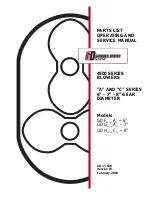
-- 6 --
OPERATING POSITION
Blower
Eye
Protection
Vacuum
OPERATING TIPS
S
While vacuuming or blowing debris, hold
the unit with the muffler side facing away
from your body and clothes (see OPERAT-
ING POSITION illustration above).
S
To reduce the risk
of hearing loss
associated with sound level(s), hearing
protection is required.
S
To reduce the risk of injury associated with
contacting rotating parts, stop the engine be-
fore installing or removing attachments. Do
not operate without guard(s) in place.
S
Operate power equipment only at reasonable
hours--not early in the morning or late at night
when people might be disturbed. Comply with
times listed in local ordinances. Usual recom-
mendations are 9:00 a.m. to 5:00 p.m.,
Monday though Saturday.
S
To reduce noise levels, limit the number of
pieces of equipment used at any one time.
S
To reduce noise levels, operate power
blowers at the lowest possible throttle
speed to do the job.
S
Use rakes and brooms to loosen debris be-
fore blowing.
S
In dusty conditions, slightly dampen sur-
faces or use a mister attachment when wa-
ter is available.
S
Conserve water by using power blowers
instead of hoses for many lawn and garden
applications, including areas such as gutters,
screens, patios, grills, porches, and gardens.
S
Watch out for children, pets, open windows,
or freshly washed cars. Blow debris away
safely.
S
Use the full blower nozzle extension so the
air stream can work close to the ground.
S
After using blowers and other equipment,
CLEAN UP! Dispose of debris in trash re-
ceptacles.
BEFORE STARTING ENGINE
WARNING:
Be sure to read the fuel
information in the safety rules before you be-
gin. If you do not understand the safety rules,
do not attempt to fuel your unit. Call
1-800-554-6723
.
FUELING ENGINE
WARNING:
Remove fuel cap slowly
when refueling.
This engine is certified to operate on
unleaded
gasoline.
Before
operation,
gasoline must be mixed with a good quality
synthetic
2-cycle
air-cooled
engine
oil
designed to be mixed at a ratio of 40:1.
Poulan/Weed Eater brand synthetic oil is
recommended. Mix gasoline and oil at a ratio
of 40:1. A 40:1 ratio is obtained by mixing 3.2
ounces (95 ml) of oil with 1 gallon (4 liters) of
unleaded
gasoline.
DO
NOT
USE
automotive oil or boat oil. These oils will cause
engine damage. When mixing fuel, follow
instructions printed on container. Once oil is
added
to
gasoline,
shake
container
momentarily to assure that the fuel is
thoroughly mixed. Always read and follow the
safety rules relating to fuel before fueling your
unit.
IMPORTANT
Experience indicates that alcohol blended
fuels (called gasohol or using ethanol or
methanol) can attract moisture which leads to
separation and formation of acids during
storage. Acidic gas can damage the fuel
system of an engine while in storage. To avoid
engine problems, empty the fuel system
before storage for 30 days or longer. Drain the
gas tank, start the engine and let it run until the
fuel lines and carburetor are empty. Use fresh
fuel next season.
Never use engine or
carburetor cleaner products in the fuel tank or
permanent damage may occur.
NOTE:
Unit must be placed on its side when
adding fuel (see illustration below).
TO STOP THE ENGINE
D
To stop the engine, move the throttle lever
to the STOP position.
BEFORE STARTING THE ENGINE
WARNING:
You MUST make sure
the tubes are secure before using the unit.
D
Fuel engine. Move at least 10 feet (3 me-
ters) away from the fueling site.
D
Hold the unit in the starting position as
shown. Make sure the blower end is di-
rected away from people, animals, glass,
and solid objects.






























